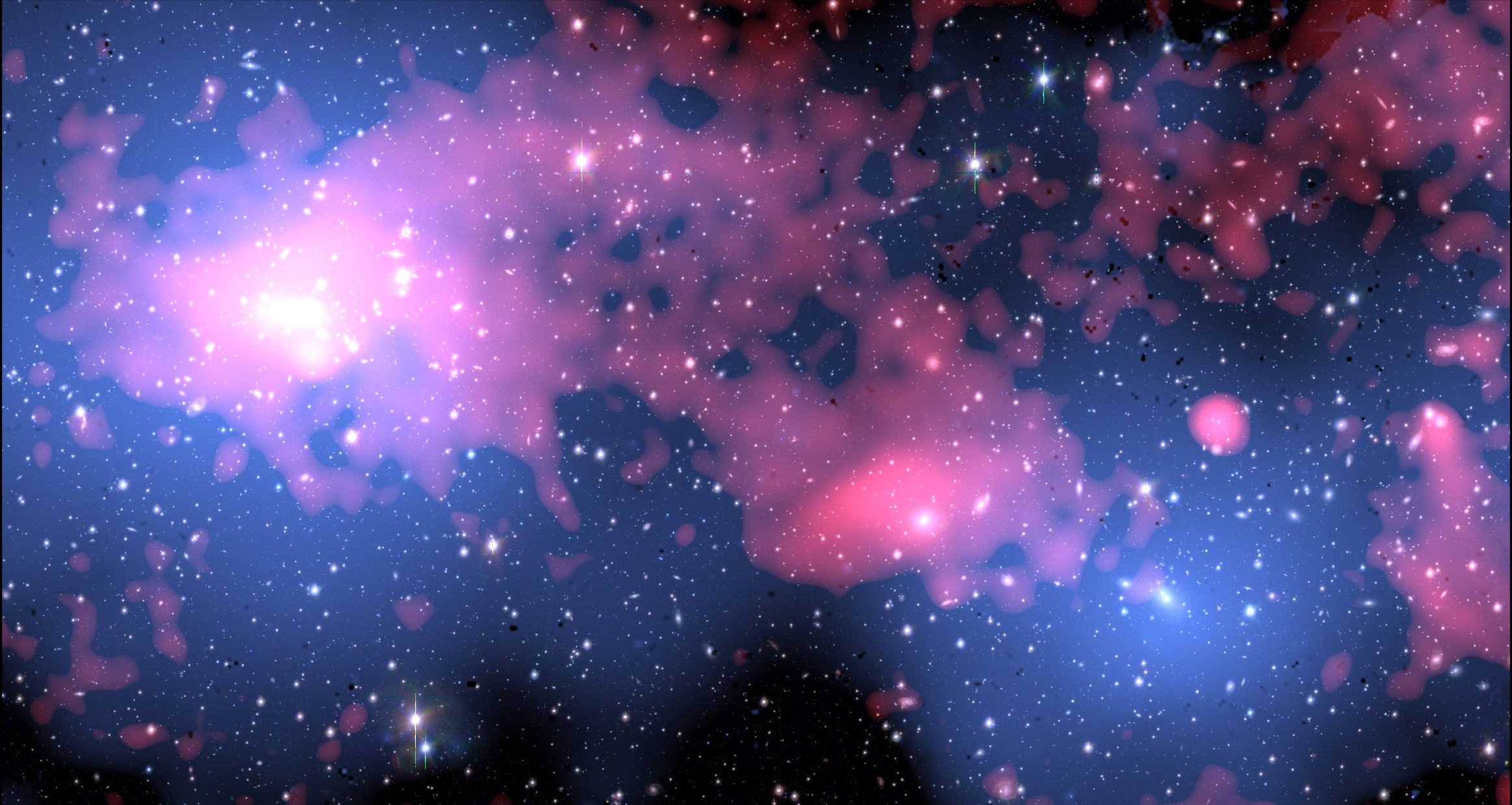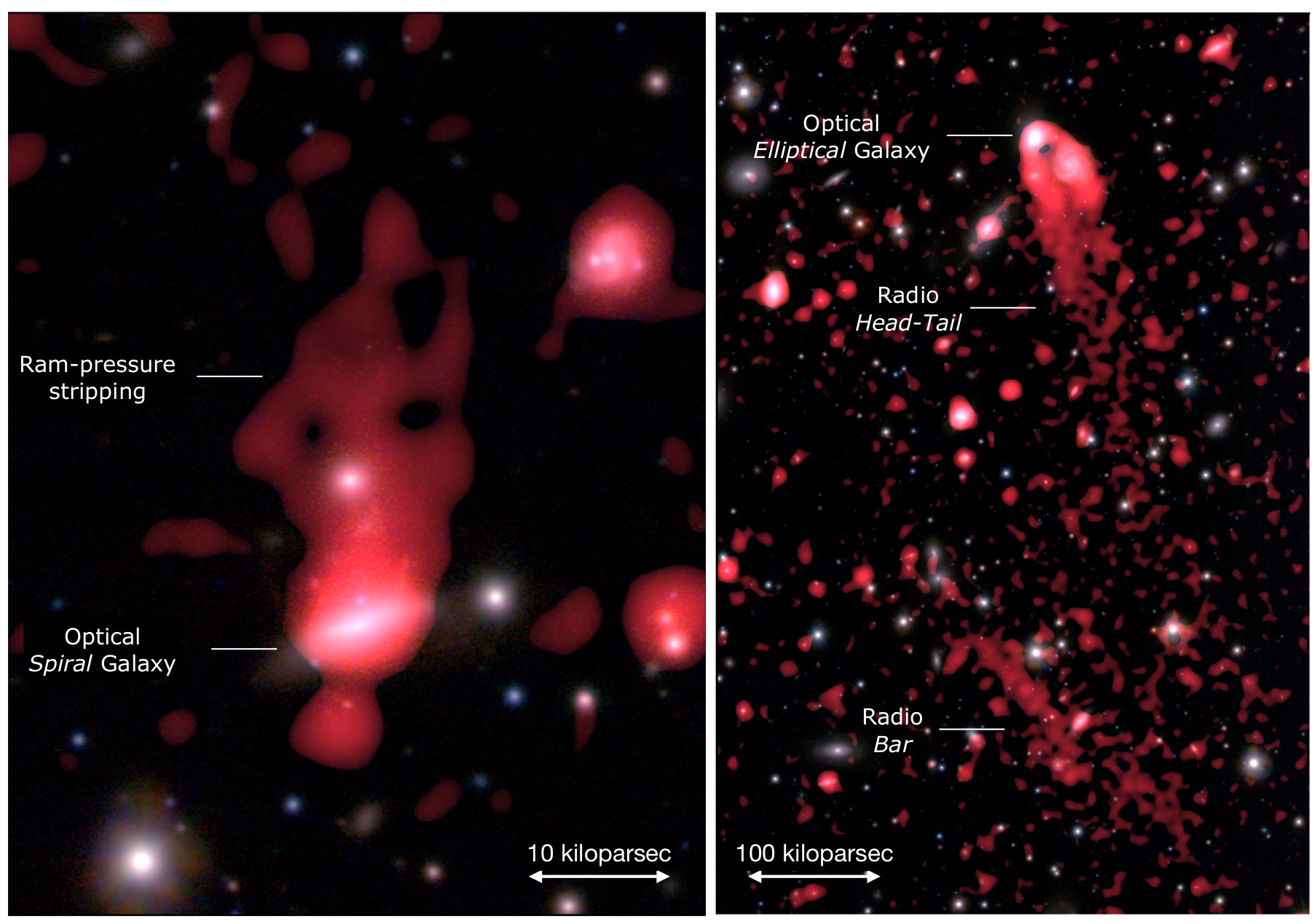Radio Evidence of a Minor Merger in The Shapley Supercluster
A group of astronomers led by the Italian National Institute of Astrophysics with contributions from the Argelander Institute for Astronomy (AIfA) at the University of Bonn has conducted a multi-frequency and multi-band study of the Shapley Supercluster, where the formation of large structures is ongoing at the present cosmological age. Radio astronomers have Discovered a radio emission that acts as a "bridge" between a cluster of galaxie and a group of galaxies. The latter recently collided with the cluster like a gian bullet that triggered the emission. The observations, reported in an AstronomY & Astrophysics article, were carried out with the Australian ASKAP radio telescope, the South African MeerKAT radio telescope, and the Indian GianT Metrewave Radio Telescope (GMRT). Optical data collected with ESO's Vlt Surve Telescope (VST) and X-ray data from ESA's XMM-Newton space telescope completed the study.
Tiziana Venturi, Director of the INAF’s Radio Astronomy Institute and lead author of the article, explains: "This exceptional emission finally allows us to study the regions between clusters of galaxies, the ideal environments to look for traces of interaction between these structures. In the study, we also report the discovery of another couple of objects - a very peculiar head-tail radio galaxy and a ram-pressure stripped spiral galaxy, whose origin is traced back to the same collision phenomenon that generated the emission on the megaparsec scale". The emission is extremely weak and difficult to detect; it extends on the scale of millions of light-years, and it takes the form of an arc and a filament.
The Shapley Supercluster is the largest in the local Universe. It covers a large area of the southern hemisphere sky 600 million light-years from the Milky Way in the Centaurus constellation. As a result, the region hosts a large number of clusters and groups of galaxies, which allows an in-depth study of the role of the environment on the evolution of galaxies and on the thermal (gas) and non-thermal (radio emission and magnetic fields) components that make up the clusters of galaxies.

Composite image of the central region of the Shapley Concentration. In the background, the optical emission of the galaxies seen by ESO-VST in r-band; the hot gas emission that permeates the whole region is represented in blue and was revealed by XMM-Newton; the radio emission, detected by MeerKAT, is described in red. The entire image covers a sky area of approximately 3x1.5 Mpc (or 10x5 million light-years). Credits: G. Di Gennaro
This region sparked the interest of radio astronomers in the 1990s. However, before the advent of ASKAP and MeerKAT (the two precursors of the SKA project, respectively managed by Australia's national science agency, CSIRO, and by the South African Radio Astronomy Observatory), it has been impossible to undertake the study which led to these results, due to the lack of interferometers with the adequate sensitivity in the Southern Hemisphere. Venturi adds: “Finally, ASKAP and MeerKAT have allowed us to access the Shapley Concentration with the resolution and sensitivity appropriate to the study we have always had in mind. The synergy between the very high-quality radio data and other X ray and optical data belonging to the team allowed a very detailed study.”
The radio data represent the state of the art of precursors of the SKA project and provide only a first taste of the wealth of information and discoveries that will come with the SKA radio telescopes (the construction will start in 2022 in Western Australia and South Africa), as well as the complexity of the data analysis that radio astronomers will have to face soon.

The panels are a zoom on the ram pressure stripped galaxy and on the head-tail radio galaxy and show the radio emission at the highest angular resolution (in red) superimposed on the ESO-VST optical image in the r band. Credits: G. Di Gennaro
“Our study" - Tiziana Venturi underlines - "originates from the curiosity to highlight the observational effects of the so-called minor merger phenomena, i.e. the formation of large structures starting from constituents of intermediate mass. The energy involved in these phenomena is lower than in the more massive brothers (the so-called major mergers). Until now, it was not clear whether scale relations between the various observational quantities would also apply to these phenomena, less striking but much more common in the Universe. However, the study has shown that these phenomena can be awe-inspiring and that they leave detectable traces on single galaxies, on clusters and groups of galaxies, even up to the regions between them."
And she concludes: "The observations confirm the expectations about the importance of SKA precursors on the understanding of the weak population of radio sources in clusters both associated with individual galaxies and associated with the intracluster and inter-cluster medium.” Thomas Reiprich from AIfA, co-author of the paper, adds that the study has also impressively demonstrated that access to data from all wavebands is required to truely see the big picture.
The results of this study are part of Radio Sky 2020, a bilateral scientific and technological cooperation project between Italy and South Africa funded by the Italian Ministry of Foreign Affairs and International Cooperation and the National Research Foundation of South Africa, which has the exploitation of the scientific potential of MeerKAT has among its main objectives.
CSIRO's ASKAP radio telescope is located on the Murchison Radio-astronomy Observatory in Western Australia. The observatory is managed by CSIRO, Australia’s national science agency, and was established with the support of the Australian and Western Australian Governments. CSIRO acknowledges the Wajarri Yamatji as the traditional owners of the observatory site.
Related journal article:
- “Radio footprints of a minor merger in the Shapley Supercluster: from supercluster to galaxy scales”, Venturi T., Giacintucci S., Merluzzi P., Bardelli S., Busarello G., Dallacasa D., Sikhosana S. P., Marvil, J., Smirnov P., Bourdin H, Mazzotta P., Rossetti M., Rudnick L., Bernardi G., Bruggen M., Carretti E., Cassano R., Di Gennaro G., Gastaldello F., Kale R., Knowles K., Koribalski B. S., Heywood I., Hopkins A.M., Norris R. P., Reiprich T. H, Tasse C., Vernstrom T., Zucca E., Bester L. H., Diego J. M., Kanapathippillai J., 2022, Astronomy & Astrophysics, arXiv:2201.04887
Media contacts:
Prof. Dr. Thomas Reiprich
Argelander-Institut für Astronomie (AIfA)
Universität Bonn
Tel. +49 228 73-3642
E-Mail: reiprich@astro.uni-bonn.de
INAF Press Office
Marco Galliani
Tel. +39 335 1778428
E-Mail: ufficiostampa@inaf.it
- 17.01.2022